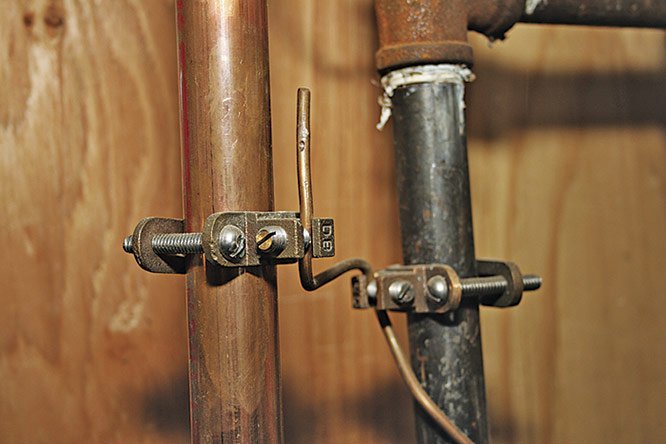Electrical Inspection: Grounding and Bonding
When talking about electrical inspections, there can be many ways and different forms for a broad range of applications. In this overview, we are speaking directly about the items that may come up during a “home inspection” during the purchase or sale of a home, when it relates to the electrical system. Keep in mind that different areas and jurisdictions have different rules and tendencies. This is just what we can share with you about ours.
THE SCENARIOS
First off, lets describe a relatable scenario. One we can all put ourselves in or may have already experienced. Here are the basic two.
1. We’re selling our home, and we know a home inspection is going to be a part of the transaction. We would all love to know what they are going to look for and even more, what they are going to find. Most of us would, if we could wave a magic wand, look forward in time and see exactly what is that we are going to be confronted with before it happens.
2. Were buying a home, and we would like to know the state of the entire electrical system so we will know what we are in for now, and down the road with this investment. We know a home inspection is coming, but what if they don’t catch everything? Do I need to have a contractor look at each system thoroughly or is one size fits all good enough? Or the real question could be asked, “what do I stand to lose if I do not?”
Both of these scenarios seem like they could be exactly the same, but they are not. When we are selling a home, it is much less likely we are going to want to search with a fine-tooth comb to find problems that will not only delay or stop the sale, but could also cost a substantial amount we may not be prepared to invest.
In the later case, we typically would like to pull out that fine tooth comb and use it on every area of the house, as that could potentially be our new home. Our families’ lives and safety are now on the table. Not to mention the large investment of time and money. You can see how these two mindsets can be a bit different. But in the end, an inspection is likely to take place, and for better or for worse, here, in general terms, is what you can expect.
Grounding and Bonding
Due to the nature of grounding in an electrical system, rest assured it will fall somewhere on the inspectors list. And probably somewhere near the top. That’s why were tackling this item first.
What is grounding and why do we need it?
Grounding is the means by which overcurrent is discharged safely out of your home. Mainly to prevent injury, damage and fire. A good grounding system in a home is so important, its continuity is relied upon for basic safety features like tripping breakers and surge protection. Without it they would not function properly if at all.
So where do we start?
We don’t even need to step foot in the house to begin our investigation. Lets walk around the back of the home where we will generally find our electrical service. Your going to see the electrical meter, and either a riser (pipe going up to meet your utility line) or a service lateral. (the underground pipe coming up to the box)
Now lets go hunting. Since we are just looking for grounding, let’s see if we can find a bare copper wire coming out of the meter box and going down into the ground. This wire should be at least a #6 bare conductor (about the width of a sharpie tip) and it should be attached to what’s called a ground rod. A ground rod is typically an eight foot long by ½ in wide stick of metal with a copper coating.
If this is what you find, you’re in good shape! If not take some pictures and add this to the list. Lastly, if you have power to any outbuilding like a shop or detached garage, you will need the same ground rod installed at each location. Now let’s make our way inside.
The next step is to find the water main. These are usually in the basement on the street side of the home. It’s very common for the utilities to be ran in the easement of the street so its very possible your water meter is on this side as well. Now that we’ve located our water main, let’s look for that same shiny copper wire that we found outside at the meter.
There should be some kind of clamp within five feet of the shut off, with a wire that travels all the way back to our first means of disconnect, which is usually our main panel. For those of us with a main disconnect on the exterior of our homes by the meter, the ground should extend all the way to that location. If there is one, you’re in good shape. If there is not grab your pen and add this to the list.
Just a note, if your thinking, Brandon I don’t need one at the main because I have a connection to the water right above my panel, this is a discussion worth having. Yes, they used to allow this to be the connection point in the past. Enter PEX. Once the use of indoor water rated plastic piping began to be the standard, hitting the water line anywhere but the main became worthless.
Just imagine that waterline travels from above your panel around the basement and then out to the water main about 10 to 15 feet underground. That’s why its your best source to earth. Let’s say you call a plumber to fix a leaky faucet, or add a line for dishwasher. There is a good chance he will cut that line and install a short piece of plastic tubing inbetween the two sections of copper that used to carry your electrical ground. Now you have major potential for damage if that ground is ever needed. Now let’s move to the gas line.
Now that we’ve made sure your water line is grounded, let’s look for the gas bond. The main reason for bonding the gas to the water is to stop static charge from building up, causing potential explosive dangers. Almost all houses use flexible gas tubing.
This is the main reason we bond. These flexible lines are a week point and need to be protected from electrical charge. Look around your water heater if it is gas. That’s where you will usually find a small connection of ground wire from the water to the gas line.
If your gas line at your furnace is hard piped and not flexed, you may not need this precaution.
Now that we’ve finished with the water and gas line, let’s find our electrical panel, and very carefully remove the cover.
(WARNING!! If you are not comfortable or do not feel safe removing the cover of your panel, please by all means do not do so)
We always suggest shutting off the main breaker on your panel to reduce the risk of shock during this phase. You will want to have a head lamp or good flashlight handy as the lights will be out once the main breaker is turned off. Keep in mind there will still be energized parts and you should not touch any components without the instruction and guidance of an experienced professional. This is a visual inspection only. Here we are looking for the following times.
If there is a metal pipe coming from the meter, there will need to be a bond bushing connecting the metal raceway to the ground bar.
If this is your main panel, all grounds and neutrals will be bonded on the same ground bar or bars. However, if you have a main disconnect outside, or a main outdoor panel that feeds the interior panel, all grounds and neutrals will need to be separated. This helps keep the main ground path the path of least resistance, ensuring your breakers trip quickly and properly.
Once you have identified the proper set up for your situation, carefully install the panel cover and turn back on the main breaker. As always take precautions. We encourage you to stand to the side of the panel, out of the way of any potential arc flash, turn our head and cover your eyes with our free hand. This is the best practice for repowering your panel or any electrical equipment.






